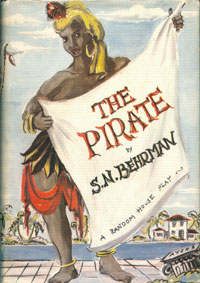|
 |
The
Pirate
S. N. Behrman
New York:
Random House, 1943
First edition in dust jacket |
| Behrman’s next
effort was to adapt in 1942 Ludwig Fulda’s early
twentieth-century revel, The Pirate. It is a bedroom
farce lacking the intellect which infuses Giraudoux’s
Amphitryon 38, but it provided escapist entertainment
for an anxious society enmeshed in a global war. Adapted on
request from the Lunts, the emphasis focused on their
bravura performance, particularly Alfred’s, as he danced,
sang, walked a tightrope, and did feats of legerdemain. The
story is minimal at most, and the New York Times’s
favorable review referred to the evening quite rightly as
burlesque or vaudeville. In The Pirate, a roving band
of entertainers, led by the intrepid and wily Serafin,
arrives at a small village somewhere in the West Indies. One
of the inhabitants, Manuela Vargas, wife of the local censor
from whom the entertainers must obtain a permit to perform,
discloses to Serafin her romantic nature by revealing her
fantasies concerning the notorious pirate, Estramudo. Bent
on seduction, Serafin assumes the identity of Estramudo
after recognizing Manuela’s husband as the real seven-seas
marauder, since retired. His impersonation of Estramudo
brings the Viceroy and his soldiers in pursuit of glory, not
to say financial reward, for the capture of the pirate.
Manuela, however, mesmerized by the dashing "pirate," saves
the day, the play, and Serafin’s neck. The Pirate was
produced by the joint partnership between the alienating
Theatre Guild and the Playwrights’ Company. The Company
recommended closing the unengaging production out of town
following devastating reviews. The Guild’s Langner, however,
insisted that everyone’s expertise, if applied, could doctor
the spectacle. His faith resulted in financial rewards, the
consequence of a lengthy run, and a movie sale. |
|